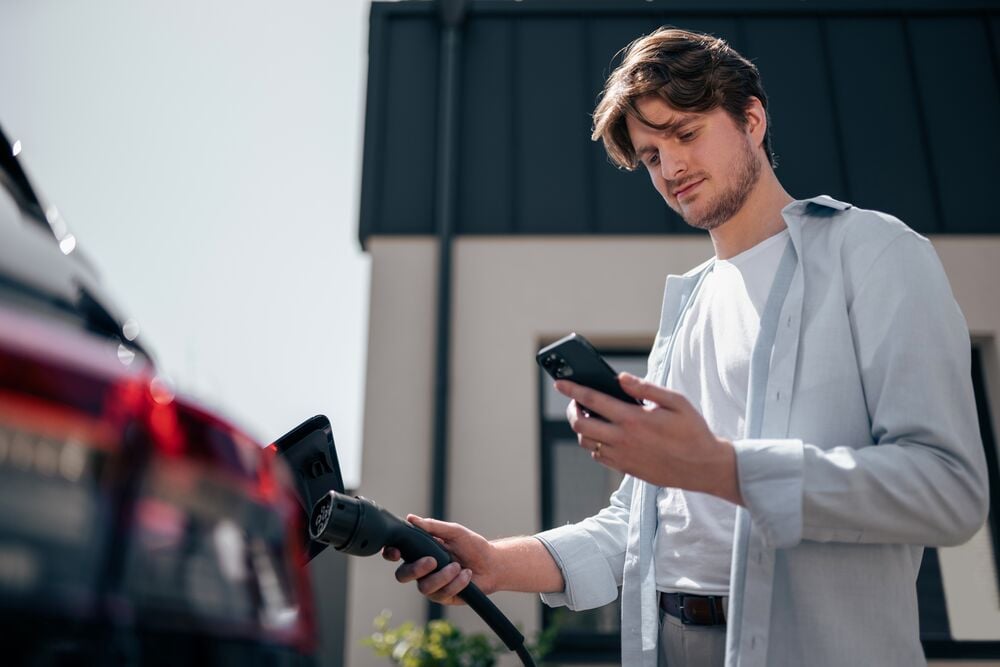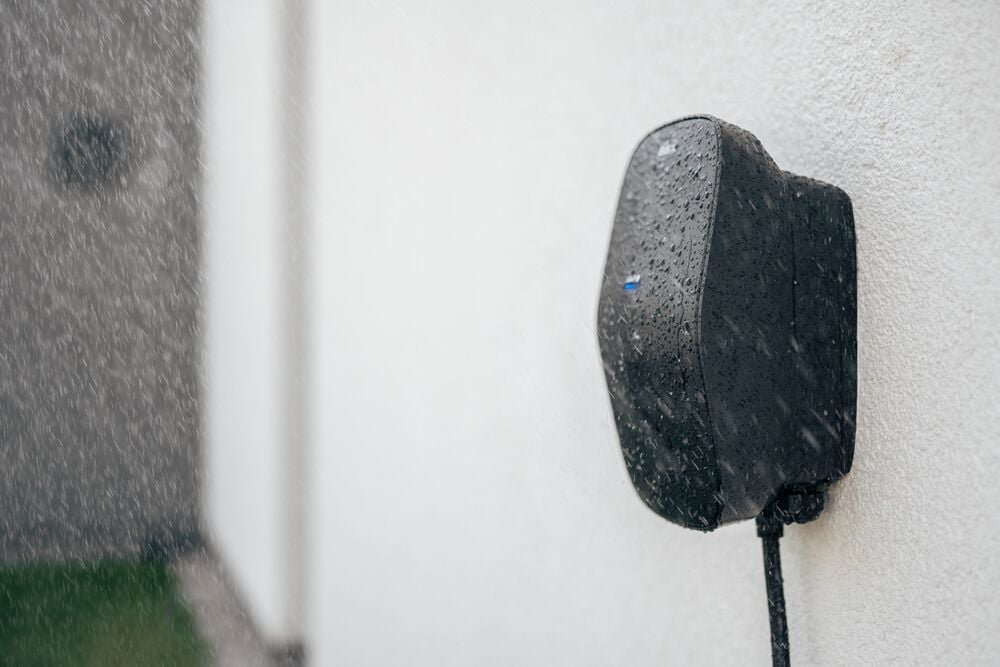Home EV charging is a popular choice
The home is by far the most popular location for EV drivers to charge their cars, and understandably so – the convenience of plugging in at night and waking up with a full battery is easy to get used to. That said, if handled incorrectly, home charging can be unsafe. In fact, 74 percent of EV drivers in the UK admit to charging their EVs at home in dangerous conditions.
So, what exactly constitutes dangerous charging? And how can you charge your electric vehicle safely? Read on to find out everything you need to know about charging your EV at home safely.

Charging at home can be dangerous—if done incorrectly
There are many ways to charge your electric vehicle at home, and home charging is unsurprisingly renowned for its convenience. However, while home EV charging is safe with the correct precautions, bad habits, and carelessness can also make it dangerous.
Before we explore what can make home EV charging dangerous, let’s first touch on the different levels of charging. Level 3 (fast) charging is the fastest type of EV charging; however, because of the high power output required, you won’t find these chargers at residential locations.
Instead, home EV charging is most likely to be either Level 1 or 2. Level 2 charging refers to dedicated home EV charging stations. Given their relatively fast charging speed and the lower power output required, you’ll typically find Level 2 chargers at commercial or residential locations.
Level 1 charging is the slowest charging level, but it’s also the most accessible. It works by plugging the cable that came with your EV into a regular wall outlet. This, however, is where the potential dangers begin.
Unsafe charging is more common than you think
Many EV drivers charge their electric (or plug-in hybrid) vehicles with extension cords that are not suitable for EV charging. According to a survey conducted among 1,500 EV and plug-in hybrid vehicle (PHEV) owners in 2019, UK admitted that nearly three out of four charge their EV using an extension cord. Some owners even connect several extension cords together in a “daisy chain” to cover longer distances, while others use extension cords in their driveway designed for indoor use only.
..jpg?width=800&height=534&name=Orange%20Extension%20Cord%20(1)..jpg)
It’s not hard to see how these charging methods could be dangerous. And while it might be tempting to cut corners with EV charging, is it really worth trading your safety for convenience? So, let’s take a closer look at each charging method and help you find the safest option to charge your EV moving forward.

Do you need a charging station for an electric car?
Not necessarily, as every electric car typically comes with a charging cable that enables you to charge your EV via a domestic socket. Thanks to strict automotive safety standards, these cables are normally fitted with protections to prevent overcurrents.
However charging your EV using a domestic socket can still be dangerous.
Sure, the standard protections are good news for your car and whoever is handling the cable. However, they're not always enough to protect your home’s power outlet from overheating. This is especially true for houses with old electrical installations.
What’s more, charging your EV on a domestic socket takes a long time. Standard household outlets can deliver up to 2.3 kW (10 A). To put that into perspective, that means it would take over 25 hours to charge a 50 kW Peugeot e-208 from 0 to 80%.
Therefore, we only recommend using a household outlet to charge your EV if it’s an emergency. It’s not a sustainable solution for recharging your EV on a daily basis.
Can you use an extension cord for your EV charger?
If charging an EV on a domestic outlet is dangerous, it goes without saying that adding an extension cord—or several—into the mix makes things even riskier.
Charging your EV with an extension cord is dangerous
EV charging requires far more power than your other standard household appliances, and most domestic extension cords are simply not designed to transfer that much power, nor are they made to be outside. Not only are they more likely to give you an electric shock, but they can also increase the risk of electrical fires.
Therefore, we never recommend using extension cords to charge your EV.

Charging your EV with a reinforced socket
It is possible to use a reinforced socket, or in technical terms use a IEC 60309 (CEE17), to charge your electric car at home. These heavy-duty industrial outlets are designed to deliver 3.2 kW at 14 A for several hours at a time..
However, while installing a reinforced outlet might be cheaper than purchasing a home charging station, you still need to fit your outlet with a suitable circuit breaker. Also, it might not be the most optimal investment in the long run. As charging with a reinforced socket will still take longer than charging with a dedicated charging station and it doesn’t add any value to the charging experience in the way that a charging station can.

The safety of a certified charging station
Charging stations are purpose-built to help you get the most out of your electric vehicle. This means they are safer, faster, and more robust than any other non-certified charging method.
Thanks to integrated safety features, charging stations dramatically reduce the risk of fires and electric shock. For example, if an electrical fault occurs, your charging station will stop the power transfer immediately and de-energize the cable. Not only does this protect your safety, but it also saves your EV, home, and grid connection from unnecessary strain.
Next to a safe charging experience, charging stations power your vehicle much faster than if you were to use a domestic socket. On an 11 kW home charging station, for example, it would only take five hours and 15 minutes to charge a 50 kW Peugeot e-208—that’s five times faster than a home outlet. That means you can return home on an empty battery and be ready to go again the next day.
What’s more, charging stations often come with a range of smart functionalities to help you balance your energy usage. They’re also designed to withstand extreme weather conditions, so you never have to worry about running electricity cables in the rain. Using a certified charging station is always the safest option.

Take electrical safety seriously when it comes to EV charging
While charging your EV with an extension cord might seem like the cheaper, more convenient option, the dangers of electricity should never be taken lightly.
Luckily, there are many safer alternatives.
If you’re charging an EV, it’s always a good idea to use a certified charging station installed by a professional. This is also the case for when you’re charging your EV at home.
Next to convenience and a range of smart functionalities, home EV charging stations are designed to offer the safest EV charging experience for you and your vehicle.


..jpg?width=800&height=534&name=Orange%20Extension%20Cord%20(1)..jpg)



